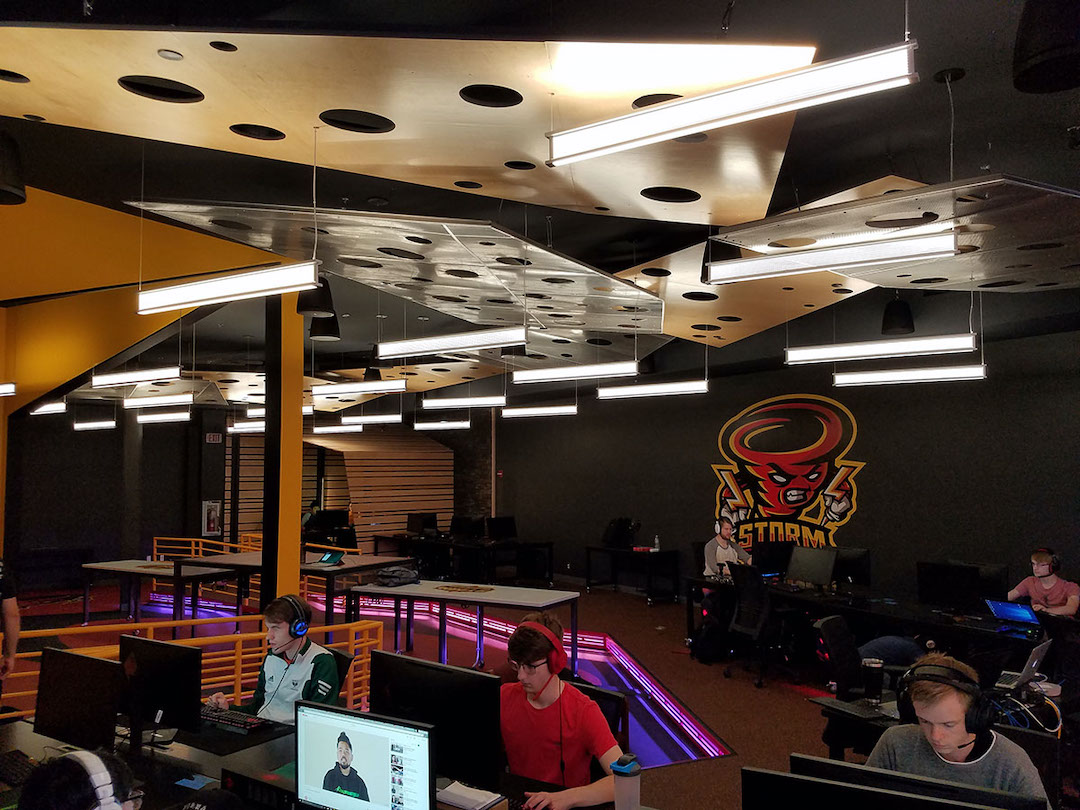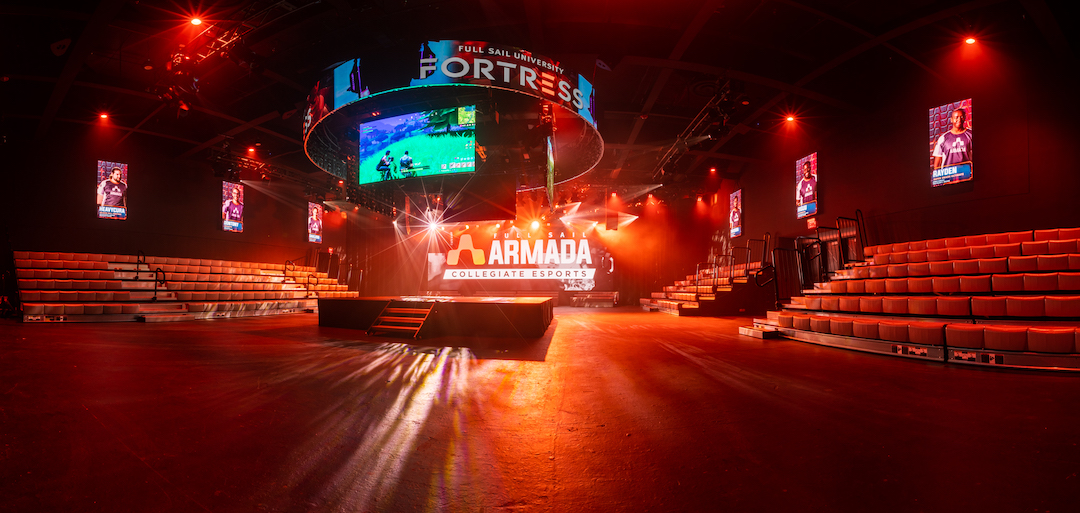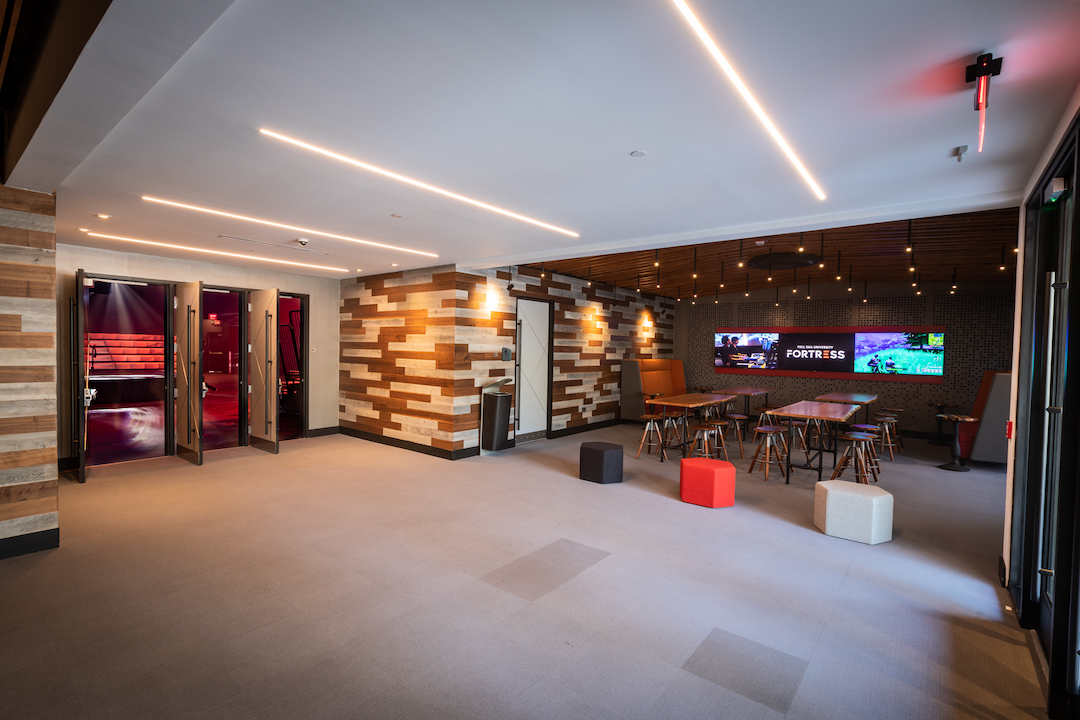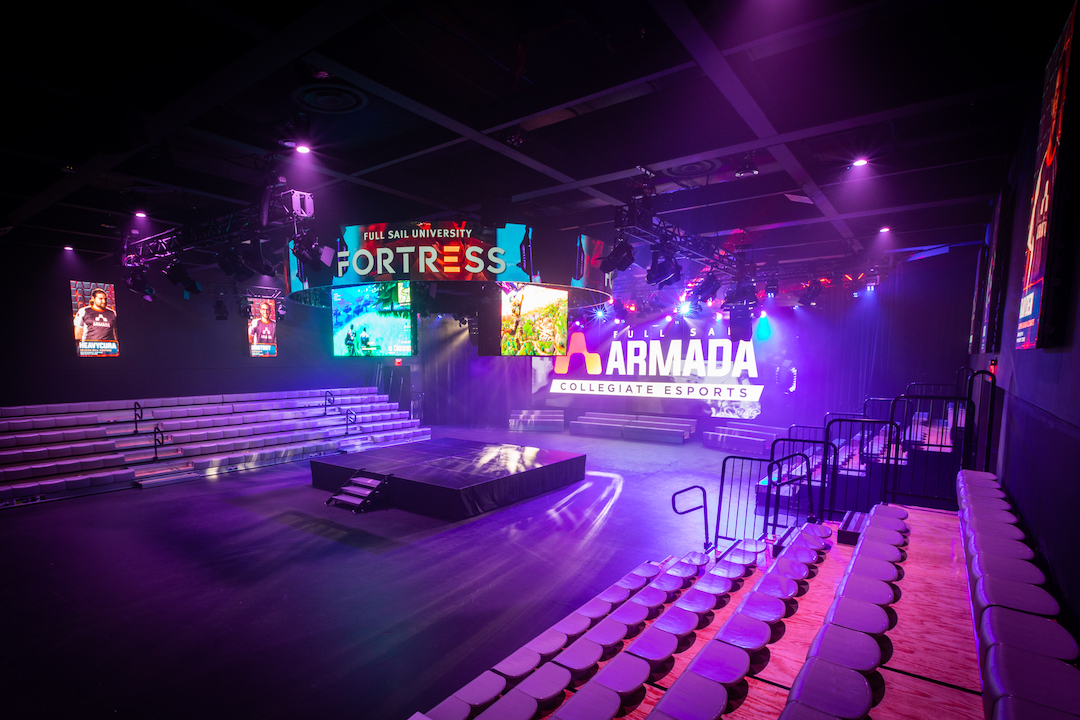The success and popularity of eSports is no longer a surprise to anyone. Purpose-built eSports stadiums are popping up both around the country and the world, hosting events with audiences and prize pools pushing well into the millions.
But now the eSports rocket ship is continuing its journey through the stratosphere, pushing ahead on another front: the college campus. In 2018, Ashland University became the first school in the country to offer scholarships (up to $4,000) for competitive gaming. Other colleges quickly followed suit, and there are now over 60 colleges in the United States offering scholarships in a variety of different games. Robert Morris University offers a scholarship for the game League of Legends that totals $76,000 over a four-year period (50% tuition and 50% room and board per year), rivaling scholarships offered for more traditional sports.
With money like that being thrown around, it’s clear video games are no longer just a hobby; eSports have become a very real and very unique recruiting tool, especially among smaller schools that can’t compete with D-I schools in sports like football and basketball.
See Also: Gamers paradise: The rise of eSports arenas
“The smaller D-II, D-III, and Ivy League schools now have an opportunity to compete on a larger scale and are really embracing eSports,” said Benedict Dubbs, Jr. AIA, LEED A.P., Principal, Murray Associates Architects. “Where else can ‘David beat Goliath’ anywhere in the world without a road trip?”
But in order for David to beat Goliath, they need an arena to fight in. Which is why small colleges such as Harrisburg University of Science and Technology (HU) and Full Sail University have taken it upon themselves to create dedicated eSports arenas and facilities for their student eSports athletes.
HU’s eSports Training Arena
The Storm, HU’s competitive eSports team, recently received a new training facility courtesy of Murray Associates Architects. The architect took a vacant dance studio in the Whitaker Center for Science and the Arts and turned it into HU’s eSports Training Arena.
The 2,460-gsf facility features 24 gaming rigs, a coaching suite, and a student lounge, all designed to enhance the team’s coaching and player collaboration, interactions, and skill development. Flexibility was also a main design focus for the space. Some competitive games are played 1 vs 1, while others pit larger teams against each other. Different games require different set ups, and the relatively small 2,400-sf space needed to be able to accommodate them all.
 Photo courtesy HU.
Photo courtesy HU.
The entirety of the arena’s power and data cabling runs beneath a custom-designed raised floor with 35 grommets that open access panels. “This design element allows HU to rearrange the gaming stations, pull cable, and quickly rearrange the entire training arena,” said Dubbs. “The concealed cabling is also a safety solution; students can move freely about the space without any trip hazards.”
In fact, the only static power and data in the entire arena was installed in the center core island, or “bullpen,” which is hardwired to the sides of the tables. The bullpen supports team meetings, strategy sessions, socializing, dinners, and other collaborative activities, so having access to technology was vital.
 Photo courtesy HU.
Photo courtesy HU.
The eSports Training Facility differs from more commercial eSports arenas in that it is for players and coaches only. HU Storm matches are viewed in an auditorium in another part of the Whitaker Center for Science and the Arts, meaning everything in the space is designed to help the Storm master their skills; you won’t find branded food and beverage options, a stage for the eSports athletes to play on, or other spectator-focused amenities like premium seating options.
Another lesser-known college, however, has decided to use commercial eSports stadiums as a template to create the largest on-campus collegiate eSports arena in the country.
The Fortress eSports arena at Full Sail University
The Fortress, Full Sail University’s new $6 million eSports arena, is an 11,200-sf space that can accommodate 100 eSports athletes and over 500 live spectators simultaneously. Designed by Blackenship Architects, the arena, much like HU’s Training Facility, was built to be as flexible as possible in order to support any size eSports event. Unlike HU’s space, however, The Fortress was designed not only to be at the forefront of eSports facilities for the college’s athletes, but for spectators as well.
As such, The Fortress features 10 million pixels of LED wall, a concert level PA system, modular wood beam ceilings, live streaming equipment, dynamic sound and lighting solutions, the latest generation live video equipment by Ross Video, Sony video monitors and cameras, large high-resolution LED screens by Absen, multi-zone loudspeaker systems by L-Acoustics, media servers by Green Hippo, and high-bandwidth dedicated internet connectivity. All of this technology combines to create an “intense spectator experience,” according to Stella Posada, Sr. VP of Image & Design at Full Sail University. “We knew we wanted to provide the best eSports experience for both competitor and viewer alike, so it was a priority that we collaborated with thought leaders throughout our various internal teams,” Posada said.
 Photo courtesy Full Sail University.
Photo courtesy Full Sail University.
And while Full Sail University approached the project using commercial eSports venues as inspiration, The Fortress also fulfills a unique roll for the school’s students. Each live event hosted in the space provides students the opportunity to hone their skills in areas beyond eSports, such as show production, film, graphic design, gaming, and entertainment and business.
Overall, the school approached the design of The Fortress with three main goals:
– Create a leading-edge facility to support its collegiate level eSports team, Armada
– Create a space to serve as an experiential educational learning environment
– Create a space that supports collegiate and professional level eSports events, while adding to the technology and eSports landscape of the region
 The Fortress lobby space welcomes spectators into the arena before ushering them into the main gaming and viewing space. Photo courtesy Full Sail University.
The Fortress lobby space welcomes spectators into the arena before ushering them into the main gaming and viewing space. Photo courtesy Full Sail University.
Additionally, the campus’s aesthetic had to be taken into account. “The Fortress at Full Sail University was created as a continuation of the fluid campus design allowing seamless spaces to merge throughout the campus,” Posada said.
To date, The Fortress has hosted varied events such as Call of Duty tournaments; Red Bull’s regional fighting game series, Conquest; and the Hearthstone collegiate championship finals.
Division 1 eSports arenas: Is Goliath preparing a counterattack?
While smaller universities are currently the vanguard for collegiate eSports venues, it may just be a matter of time before larger schools join the party.
Although they haven’t quite committed to the same level as smaller schools, D-I schools such as Ohio State University, Penn State, and Georgia Tech all have eSports teams that are actively competing in tournaments. Ohio State has even opened its own version of an eSports Arena with 80 gaming computers, consoles, and virtual reality systems; a room for competitive gaming with peer universities; and a broadcast booth.
Although the space is less “arena” and more “computer lab,” it is still a sign that D-I schools are taking eSports seriously. And while there isn’t the eSports equivalent of Duke’s Cameron Indoor Stadium or USC’s Coliseum yet, “yet” may be the key word in this equation.
See Also: With a new type of stadium comes a new type of premium seat
“Larger universities that have heavy technology majors are getting involved, but the majority have clubs within their student life or activities departments and are not yet embracing the incorporation of eSports into their athletic programs,” Dubbs said. “However, with the revenue for eSports approaching $1.5 billion, I believe larger universities will eventually become involved because the potential for increasing their revenue stream will be too tempting to ignore.”
For now, the David’s of the college landscape (HU, Full Sail University) are leading the eSports charge, but it won’t be long until a Goliath comes along and builds a university eSports arena to rival even the leading commercial facilities in the world. With revenue in the billions, it’s less a matter of “if,” and more a matter of “when.”
Related Stories
Architects | Jun 6, 2023
Taking storytelling to a new level in building design, with Gensler's Bob Weis and Andy Cohen
Bob Weis, formerly the head of Disney Imagineering, was recently hired by Gensler as its Global Immersive Experience Design Leader. He joins the firm's co-CEO Andy Cohen to discuss how Gensler will focus on storytelling to connect people to its projects.
Sports and Recreational Facilities | May 30, 2023
How design supports a more holistic approach to training
For today’s college athletes, training is no longer about cramming team practices and weight lifting sessions in between classes.
Arenas | May 18, 2023
How can we reimagine live sports experiences?
A Gensler survey finds what sports fans' experiences have been like returning to arenas, and their expectations going forward.
Digital Twin | May 8, 2023
What AEC professionals should know about digital twins
A growing number of AEC firms and building owners are finding value in implementing digital twins to unify design, construction, and operational data.
Collegiate Stadiums | Apr 4, 2023
6 examples of modern college training facilities
HOK discusses the future of college training facilities, with six design takeaways derived from a discussion between Dan Radakovich, Director of Athletics at the University of Miami, and Trevor Bechtold, Director, HOK’s Sports + Recreation + Entertainment practice.
Sports and Recreational Facilities | Mar 30, 2023
New University of St. Thomas sports arena will support school's move to Division I athletics
The University of St. Thomas in Saint Paul, Minn., last year became the first Division III institution in the modern NCAA to transition directly to Division I. Plans for a new multipurpose sports arena on campus will support that move.
Sports and Recreational Facilities | Mar 17, 2023
Aurora, Colo., recreation center features city’s first indoor field house, unobstructed views of the Rocky Mountains
In January, design firm Populous and the City of Aurora, Colo. marked the opening of the Southeast Aurora Recreation Center and Fieldhouse. The 77,000-sf facility draws design inspiration from the nearby Rocky Mountains. With natural Douglas Fir structure and decking, the building aims to mimic the geography of a canyon.
Sports and Recreational Facilities | Mar 15, 2023
Georgia State University Convocation Center revitalizes long-neglected Atlanta neighborhood
Georgia State University’s new Convocation Center doubles the arena it replaces and is expected to give a shot in the arm to a long-neglected Atlanta neighborhood. The new 200,000 sf multi-use venue in the Summerhill area of Atlanta is the new home for the university’s men’s and women’s basketball teams and will also be used for large-scale academic and community events.
Sports and Recreational Facilities | Feb 27, 2023
New 20,000-seat soccer stadium will anchor neighborhood development in Indianapolis
A new 20,000-seat soccer stadium for United Soccer League’s Indy Eleven will be the centerpiece of a major neighborhood development in Indianapolis. The development will transform the southwest quadrant of downtown Indianapolis by adding more than 600 apartments, 205,000 sf of office space, 197,000 sf for retail space and restaurants, parking garages, a hotel, and public plazas with green space.
Arenas | Feb 23, 2023
Using data to design the sports venue of the future
Former video game developer Abe Stein and HOK's Bill Johnson discuss how to use data to design stadiums and arenas that keep fans engaged and eager to return.

















